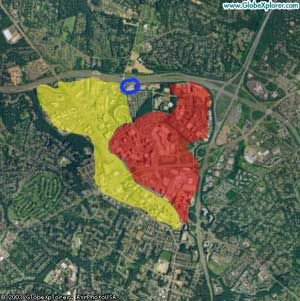
|
|
|
Sunday 17 August 2003
Urban Planning
Park-and-Ride Lots as Transit Hubs There is little, it seems, that mass-transit officials like better than buses. Buses are great, after all; they’re incredibly cheap (when compared to trains), they’re easy to deploy, they don’t require expensive infrastructure, they can be reconfigured (i.e. the bus can follow a differing route, something that’s hard to do with a train), etc. Some people complain that the problem with the bus is that it can get caught in traffic just like a car, but you can fix this with bus lanes and ‘busways’, roads that only buses can use. This removes some of the flexibility and raises the cost of your bus system, but it’s still far more flexible and much cheaper than a rail approach. No matter what you do, though, people don’t much like buses. I don’t like them; I’ll very willingly ride a train, but I don’t think I’ve been on a bus in at least fifteen years. One problem might be that train stations tend to be hubs of activity, with lots of things to do, places to live, etc. right on top of them. Bus stops — the kind of bus stops I’m talking about here, where the express buses stop — are usually located with an eye to the buses’ convenience, not the convenience of the people riding the things. Tyson’s Corner, VA is, as always, a good example for How Not To Do It.
The Capital Beltway runs vertically on the right side of the picture, and VA-267, the Dulles Toll Road, horizontally across the top. The red area is predominantly (relatively) dense retail and office space. There are two large shopping malls, a few hotels, some high-rise office buildings, etc. The yellow are is less-dense office and retail space. It’s mostly strip malls, low-rise office buildings, car dealers, and so forth. Nearly all of the rest of the space in the picture is full of single-family houses, low-rise apartments, golf courses, and the like: classic low-density suburb. The bus station, of course, is circled in blue. It’s near the ‘medium density’ area, but on the very edge, and across a six-lane road from it. And I’m being pretty generous in calling this ‘medium density’. This station gets used, but really this is only because Washington-area traffic is so awful. Unless you happen to live or work immediately adjacent to the station, it’s not much use. Had this been built a mile away, in the middle of the dense area, it’d be useful to more than just commuters. If it were near anything, there would be increased ridership of the buses and traffic through the nearby stores, and the office and residential space nearby would be worth more. As it is, this isn’t the case, and because only a few buses a day stop here (partly because it’s a destination for almost no one), there isn’t even much of a boost to the immediately-adjacent property. I write about this because it appears that transit officials in Wisconsin, of all places, have noticed the problem, if in a small way. They plan to build some ‘commuter retail centers’. These don’t sound like they’ll be all that they could be, but they represent a big improvement over nothing.
Of course, the state is selling off the land to the developer, who’ll make all the money. If the DOT were to build a shopping center themselves — presumably they’d hire out the management of the thing — they might actually show a profit and be able to decrease or eliminate transit’s dependence on subsidies. Posted by tino at 16:54 17.08.03This entry's TrackBack URL::
http://tinotopia.com/cgi-bin/mt3/tinotopia-tb.pl/177 Links to weblogs that reference 'Park-and-Ride Lots as Transit Hubs' from Tinotopia. |
